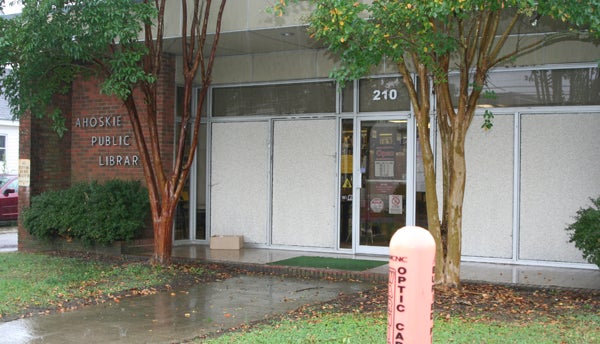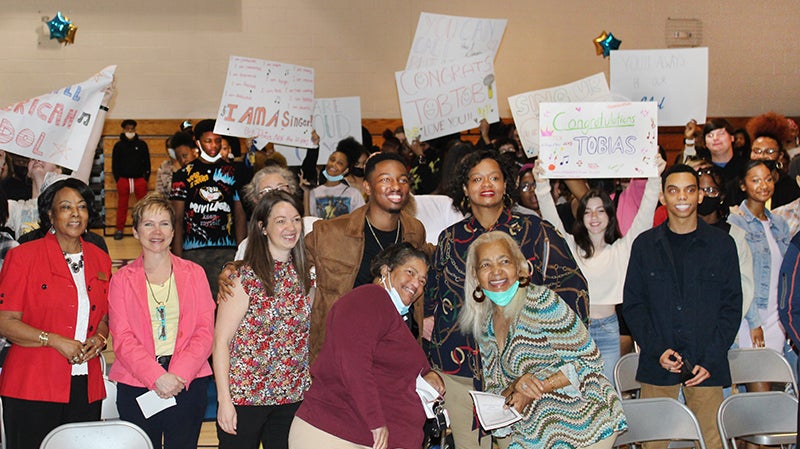Library site selected
Published 8:50 am Thursday, September 25, 2014

The Ahoskie Public Library Committee has been working for the past several years to replace the 1,700 square foot building, as shown here, on Church Street. Staff Photo by Gene Motley
AHOSKIE – The decision on where to locate a new Ahoskie Public Library has been made.
No ‘Field of Dreams’ here, because this was never a question of “if you build it, they will come”; but neither is it “go big or go home”.
The Ahoskie Public Library Committee has been working for the past several years to replace the 1,700 square foot building on Church Street – including raising nearly $190,000 in funds for the new library project.
Instead, your new movie references might be: ‘it’s now down to where you build it’, and ‘size does matter’.
The Committee had a choice of three sites to consider for the new project, all sizeable lots: Parcel-one is owned by the town of Ahoskie and located at the corner of Maple and Sunset streets, one block west of the Ahoskie Fire Department building; the second parcel is on East Main Street located next to Southern Bank between the bank and First Presbyterian Church, which would give the property entrances from Main and Church streets; and parcel-three is owned by Mike Basnight located on Hertford High School Road next to the Dollar Tree store.
“What the Library wanted Council to consider was the properties that they have been offered,” said Town Manager Tony Hammond at the Sept. 9 Ahoskie Town Council. “Their proposal is the Southern Bank property; they wanted Council’s concurrence on their selection.”
Hammond also informed Council that he, town Finance Officer Patricia Taylor Bradley, and several members of the Library Committee had met with officials of the US Department of Agriculture earlier in the month to discuss a possible application to USDA for a $50,000 grant and USDA-backed financing, since they have both grant and loan funds available.
“They want to know how you want to move forward with this project,” Hammond continued, “whether you want to go ahead and pursue with USDA for financing this project.”
The initial design for the new library involved some 12,000 to 13,000 square feet with a cost of $1.5 million. However, the building’s plans could be downsized to approximately 10,000 square feet which would reduce the cost to about $1.2 million.
“Based on the current rates and things of that nature, if USDA did fund this project, a $1.2 million dollar building for 30 years, which is what they normally do building for, it will require a tax rate increase,” Hammond said. “There is not enough money in the general fund to make a $100,000 payment for a library every year. What it’s going to equate to on the tax rate is if Council is wanting to pursue this project, then it’s going to require a 3.5 percent tax raise.”
Hammond said the USDA could expedite or slow the application process depending on the wishes of Council.
Several members of the Library Committee attended the Council meeting including Albemarle Regional Library Director Teresa Cole who spoke on the committee’s behalf.
“You have a very nice library here in Ahoskie,” Cole stated. “A town of this population should have a minimum of 10,000 square feet.”
Cole added that, among other things, the Ahoskie Library needs more computers since the sparse number of computers the library has means people sometimes must endure long waits to use them.
“It just really, really is a necessary project and I think you all have done a wonderful job with the library that you have, but I think it’s time to move into a bigger place,” Cole concluded.
Councilwoman Elaine Myers asked about the location, whether there would be adequate parking, and an estimate of the number of library patrons. Cole gave her endorsement for the Main Street property site, recommending the 1.85 acre lot should provide enough for 45-65 parking spaces and that the library had an annual circulation of 40,000 patrons.
“It’s an excellent design,” Cole added. “It will allow us to maintain that library with the existing number of staffers, but because of that layout and the location, they should be able to monitor the entire building very, very well. And remember, it doesn’t get anywhere near the usage it will get when it’s in a bigger and better location.”
Councilman Rev. C. David Stackhouse told of his church after-school program’s use of the facility and how he sometimes has to alternate the times for sending students because of the availability of the library’s computers.
“We sometimes have to send them in shifts,” Stackhouse said. “This excites me because I’m an educator and a library only enhances the whole thrust of education for our county.”
Councilman Maurice Vann proposed a multi-phase construction project spread out over multiple years to lessen, or eliminate, the tax burden.
Town Attorney W.H. “Buddy” Jones inquired if there was a time limit for construction attached to the Southern Bank land donation if the town accepted the offer. Some Library Committee members attending said they weren’t certain of any such stipulation, but believed there was a time frame within which the property donation may be withdrawn.
Myers also asked the Town Manager regarding alternate funding sources.
“I have dug and dug,” Hammond said. “USDA is the only one out there that has a grant fund that would work on the library. There are a few grants out there for 50-to-60 thousand dollars for things like hardware, installing Wi-Fi; but you can’t use those grants to go in and buy furniture and things like that. Other than that, there is nothing out there.”
Myers complimented the Library Committee for their fund-raising efforts and expressed hope the new facility could be built without raising the tax rate.
“I think we could omit that if we have enough growth in our town,” Myers said. “More income would certainly make this burden lighter.”
After hearing comments both from Library Committee members and the general public in attendance, Mayor Brien Lassiter called for a motion on the town’s acceptance of the Southern Bank property site for the new library. Stackhouse made the motion which was seconded by Myers and passed unanimously.
The Council next voted on the application of the USDA loan/grant designed to fund the project. Jones reminded the members that the vote was for the application only and that if approved the application would still have to come back to Council for a vote on the loan/grant’s acceptance.
There was also the question of holding a public hearing.
“As part of the USDA package you’re going to have to have a public hearing,” Hammond reminded Council. “This is just an authorization for us to go and put that application in; and as part of the application you have to pass a resolution and to do the resolution you have to have a public hearing.”
Lassiter reminded Council that delaying the application, even by as few as 30 days, could possibly mean the town would lose a chance at the USDA funds. Still, someone voiced questions about a tax increase.
“Tax increase wouldn’t happen until the next budget year anyway,” said Hammond, reminding those present that the tax rate could not change in the middle of the year.
“If we started building in January (2015) and we opened up in July (of the same year), then our payments (to USDA) wouldn’t start until July 2016,” he continued. “But when I put this package together one of the items in that package is a resolution by Council, which if approved, would go to Council at the October meeting and it would address the Library.”
Library Committee member Harriet Byrum told Council that there was a plan to do some private fund-raising and that part of the money raised, nearly $200,000, includes a generous donation from the late Julian Robertson of Boyette and Robertson Insurance Agency.
“We’ve got to get a plan, we’ve got to start taking some action,” Byrum said.
“Until there’s a commitment by the town for a new library it’ll be very difficult to raise funding in large donations,” said Cole. “But once they know there’s going to be a library it gets much easier to approach for donations.”
The total of funds raised also did not include the annual barbecue dinner-sale which was not held until later in the month.
At the conclusion of the discussion, the motion was made to approve the application submission to the USDA and it passed unanimously.


